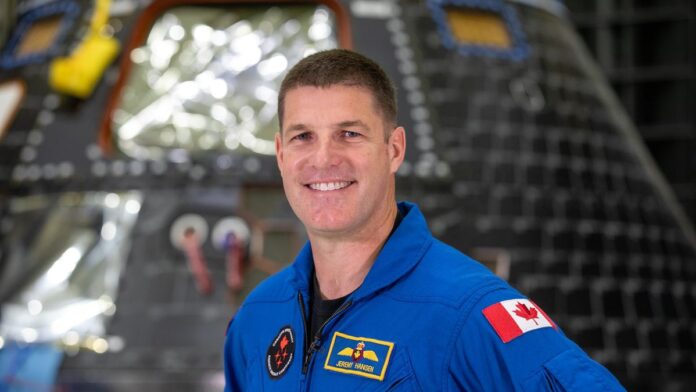CAPE CANAVERAL, FLORIDA — The astronaut who will be Canada’s first-ever moon explorer brought decades of flying experience into the simulator last week.
Artemis 2 moon astronaut Jeremy Hansen flew practice reentries into Earth’s atmosphere using a spacecraft simulator. He has decades of experience to offer in the cockpit: The Canadian Space Agency (CSA) astronaut and Royal Canadian Air Force fighter pilot will use that to help his team fly safely around the moon in late 2024.
“One of the things I’ve noticed is more computing power is needed to get us into the right places” as a spacecraft comes back from the moon, instead of Earth, Hansen told Space.com in an exclusive interview. Because there is a narrow angle to hit, “more data is required by the system to get you there.”
Hansen did his interview by phone on Monday (Aug. 7), the day before Artemis 2’s Orion spacecraft was unveiled at NASA’s Kennedy Space Center (KSC) in Florida to media here.
Hansen is a mission specialist on Artemis 2, meaning that piloting Orion will not be his primary responsibility. But his assignment to the mission is nevertheless a boon. Artemis 2 has extra time for its two mission specialists because they will not be tasked with landing activities. NASA is using part of that time for Orion spacecraft training so that as many astronauts as possible can test the spacecraft on its debut crewed mission.
Related: How Artemis 2 astronauts are training for their 2024 moon mission
Hansen is a rookie in spaceflight, but a veteran in all things surrounding it. He was selected as an astronaut candidate in 2009 with the CSA, an agency that contributes robotics to the International Space Station (ISS).
That crucial 2.3% contribution to the ISS coalition has served Canada well for decades, in that astronaut seats and science are available in exchange. But CSA only receives a spot on an ISS mission every five or six years at current flight rates. The latest generation of robotic arm, the Canadarm3, at last paid for Hansen’s first spaceflight on Artemis 2; more moon missions are planned besides.
Hansen has used his 14 years as an astronaut the ground to help with crucial agency activities for Canada and NASA. Behind the scenes, he spoke with space policymakers in Canada. More in view, he was the first Canadian to manage the training schedules of an entire astronaut class (the 2017 group). He also played a crucial role in planning tricky spacewalks to repair a key ISS science instrument known as the Alpha Magnetic Spectrometer, which examines dark matter and energy.
Now gearing up for his first flight, Hansen is learning more about space directly from his Artemis 2 crewmates, all NASA astronauts who have flown before: commander Reid Wiseman, pilot Victor Glover and mission specialist Christina Koch.
Related: Artemis 2’s Canadian astronaut got their moon mission seat with ‘potato salad’
“We’re pulling one another along,” Hansen said of the crew dynamic. “It’s like everybody wants to charge ahead with the most effect possible.”
U.S. Navy captain Wiseman, he said, is a great leader who not only is good at making fast operational decisions himself when required but also at seeking crew input when the situation allows for the time and space to do so. “He has a very collaborative approach and is very interested in inputs from everybody, and is very interested in making sure that this mission is equally challenging for all of us — and meaningful.”
Former Antarctic scientist Koch is a “really deep thinker,” which Hansen says brings a valuable perspective to the mission. “The way she dissects problem and the perspective, the balance that she brings, I just really appreciate that about her.”
Glover, also a former U.S. Navy captain, has experience launching out of KSC via a previous mission, SpaceX’s Crew-1 flight to the ISS. That’s unique among the crew, as Koch and Wiseman each launched to the station on Russian Soyuz spacecraft from Kazakhstan. Glover is introducing the crew to all the connections he made via his Space Coast launch experience, Hansen said.
“He puts a lot of effort into getting out there, and knowing people one on one,” Hansen said of Glover. “That brings a lot of value to our team, because Victor has a lot of relationships that he’s built throughout NASA and throughout the contractors that we’re working with. There’s benefit to a lot of that.”
The crew is also focused on trying to be examples for young folks watching the mission, which many at NASA call the “Artemis generation.” Hansen said that effort comes from trying to show up in venues where astronauts may not commonly go, such as the recent Artemis 2 appearances at a professional basketball tournament, on a Hollywood red carpet for the “Guardians of the Galaxy Vol. 3” premiere, or on popular TV shows like “The Late Show with Stephen Colbert.”
“We’re just grateful,” Hansen said of the opportunities the crew have received so far. “We all want to uniformly put in the extra effort to show up for the next generation.”

